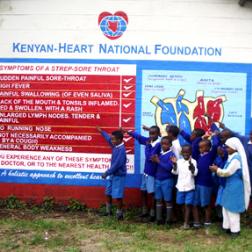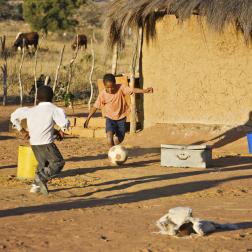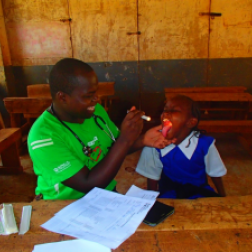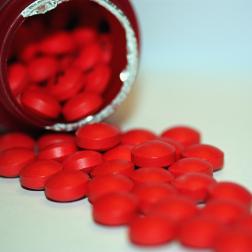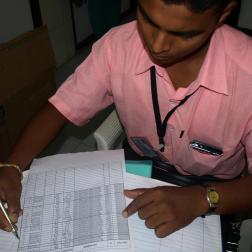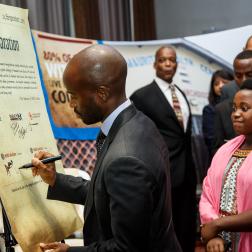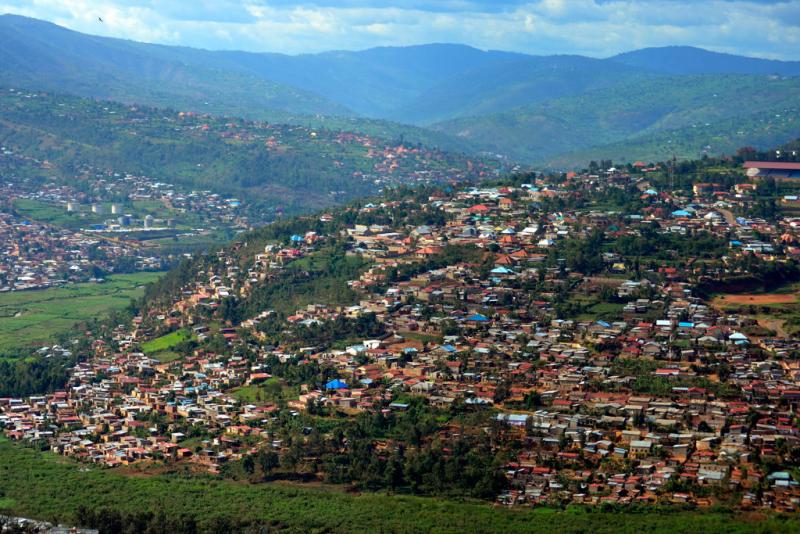Case Study | Rwanda
Prof Joseph Mucumbitsi | Paediatric Cardiologist | President, Rwanda Heart Foundation
The A.S.A.P. (Awareness, Surveillance, Advocacy, Prevention) Programme approach to RHD prevention is applied in a number of African countries. In Rwanda, one of the project demonstration sites is in the Gasabo district in Kigali. Dr. Joseph Mucumbitsi, founder and President of the Rwanda Heart Foundation and champion of the A.S.A.P. Programme in Rwanda, shared with us his experiences:
Awareness
“We want to focus on health worker training and get into schools.”
At the demonstration site in Gasabo, 10 schools were randomly selected, some urban and some rural, to take part in an echo screening campaign in conjunction with Team Heart Inc. a surgical visiting team from Boston, USA (see Case Study 8). The goal was to elucidate the prevalence of disease in the district as a first step in determining the burden of disease in Rwanda. At these schools, all students, teachers and a majority of parents were educated about RF/RHD, and RF/RHD posters were distributed. Nurses at the local health centres were trained in RF/RHD prevention and treatment. These nurses care for children from their catchment area schools.
“We want the nurses at the health centres to be the ones that own the project… with education.”
A grant from the World Heart Federation has also funded the creation of education materials for RF/RHD, including a booklet for patients with RHD to streamline follow-up care, and a protocol for health workers on how to administer BPG, prevent endocarditis and monitor INR.
Surveillance: The WHF echo criteria were used to diagnose RHD during the first echo based RHD screening campaign. 3,000 children, aged 6-16 years old, were randomly selected from the 10 schools. Plans are under way to expand the echo screening to another high prevalence region in the country to corroborate the initial findings: prevalence of 6.8/1000 in Gasabo. In the near future, 6 general practitioners’ will enrol in a one -year Diploma in Cardiology including a course on echocardiography, so that local dependence on foreign experts to perform screening is reduced. The goal is to train GPs in cardiology from all District Hospitals, which will be equipped with echo machines, so that they can help with CVD/RHD patients’ diagnosis, management and follow up care under supervision by cardiologists, through a regular outreach program.
Advocacy
“Our advocacy approach for CVDs in general and RHD in particular, started through the partnership with visiting cardiac surgery teams in 2006 aiming at building up a sustainable cardiac surgery program. Two teams currently operate on RHD patients twice a year and so far, more than 250 patients have been operated on, allowing health care system strengthening for their follow up care.”
Due to the collective advocacy efforts of the RHD community in Rwanda, the A.S.A.P. RHD model components will be incorporated as much as possible into the national strategic NCD plan. Collaboration between the RHD community and the Ministry of Education is also promising, and progress is being made toward the inclusion of RHD in the national school health education program. The school-based health care approach would be to ensure that a nurse from a local health centre is responsible for providing holistic care for students in neighbouring schools, including GAS pharyngitis treatment and referral of patients with symptoms of RF/RHD. Discussions with Partners in Health Rwanda, an NGO working with 3 District Hospitals in the country, resulted in switching from oral penicillin to injectable BPG for secondary prophylaxis. Discussions are being held with the national Treatment and Research AIDS Center to add RHD to the “TRACnet” platform, centralizing data received through internet, landline and mobile phones to monitor HIV patients’ medications and lab results. This would facilitate secondary prophylaxis follow up as well as the implementation of a web based central RHD register.
Prevention
Children who are echo-screened positive for RHD are started on monthly BPG injections. Borderline patients are not started on BPG because the natural history of asymptomatic and borderline disease remains unclear. There may be opportunities for Rwanda to become involved in international research to understand the role of secondary prophylaxis for borderline patients. Post cardiac surgery follow up care is provided through established “Points of Care” (8) throughout the country, where patients who have undergone surgical valve repair or replacement can receive follow-up care, including BPG prophylaxis and anticoagulation management. At these sites:
“Patients are seen by Cardiologists, General Practitioners or nurses and we (cardiologists) provide supervision through outreach visits, by phone or internet.”
Currently, threeportable echo machines are available so that Cardiologists can use them during outreach rotations between the points of care on a monthly basis. This will also improve early detection of RHD cases needing follow up and secondary prevention.
Challenges
There is no central registry of RF/RHD patients. Cardiologists keep spreadsheets of their own patients for follow-up purposes, but these are all maintained individually. Various web based database programs for a central electronic register are being explored. The Rwanda Heart Foundation are still advocating for the Ministry of Health to endorse the idea of a registry, ideally integrated with an existing platform and web-based. Resources to expand the A.S.A.P. model and to achieve large-scale changes are limited. Sustained progress in RF/RHD control requires government commitment. Engaging government started in 2006 with the cardiac surgery program supported by the Ministry of Health, and has strengthened since the creation of the National Non Communicable Disease Division including a CVD Unit. We have been working closely with them over the last year on the integration of RHD in the National NCD Strategic and Action plans.
Case Study | Rwanda | Team Heart
Ceeya Patton-Bolman | Registered Nurse | Program Coordinator
“Ethically, it is important to support screening and prevention programs, as well as surgical intervention. From the very beginning, prevention and early intervention was a part of our mission statement.”
Formed in 2006 after an invitation from the Rwandan Ministry of Health, Team Heart, a not-for-profit organization based out of Boston, USA, began providing surgical care for children, adolescents and young adults with RHD in 2008. The organization simultaneously engaged the Ministry of Health, local physicians and other entities to encourage and support the implementation of national efforts to prevent RHD. Ultimately, the team’s goal is to strengthen the Rwandan capacity to control RHD until self-sufficiency is attained—“The best thing that could come out of this is for surgical teams doing just patients with valve disease due to RHD to be put out of business.” Ceeya Patton-Bolman, a registered nurse and Program Coordinator, reflected on Team Heart’s efforts in Rwanda:
Components of the Program
“One of the most valuable things about cardiac surgery is that it receives a lot of attention. When we travel to Rwanda, people know Team Heart and it is easy for us to parlay that into an awareness platform.”
In 2009 Team Heart organized with the local cardiologist an RHD conference in Rwanda, which brought together cardiologists, paediatricians, the Ministry of Health, and Ministry of Education. Widespread agreement of the need to develop a national school-based screening and prevention program for RHD was shared amongst participants. A vision of a program was designed to identify and empower school nurses to educate teachers and families, diagnose and treat GAS pharyngitis, and refer patients with symptoms of RF or RHD to appropriate centres.
In 2011, a school-based screening initiative of 3,000 children in 10 schools took place in conjunction with the Rwandan Heart Foundation and MoH as part of the A.S.A.P project. Its purpose was to establish disease burden and use the data to push an awareness, prevention, and early intervention agenda. Education campaigns have targeted different populations:
Physicians
An annual national conference was held in conjunction with visiting teams.
Public
Posters were placed in local health clinics throughout the country and public forums were held at schools with parents and teachers.
Patients
“We think that our post-op patients can be our best ambassadors.” Each year post-op patients come together for a reunion where advocacy is emphasized. Post-operative patients are encouragedto speak about RHD in their communities and increase awareness about opportunities for prevention and treatment. Reunions also include counselling on reproductive health, education, and return to normal productive life and activity.
Media:
Radio shows with local cardiologists and patients have been used to raise awareness. Films, including “Heart of Courage” were used for fundraising, but were also used as tools for education in Rwanda. A skit/drama is in production and will be aired by a local TV station. Translation into Kinyarwandan will be completed soon.
“One goal is capacity building so that Team Heart is not necessary for screening… We have not reached this point yet and are still working in collaboration with local staff.”
Team Heart designed a diploma curriculum taught by local cardiologist and partner visiting faculty from the United States and Europe to train internal medicine physicians in basic cardiology and echocardiographic screening and also in the management and monitoring of heart failure. The initial cohort of 6 physicians will begin the 2-year program in 2014. Team Heart also plans to “take echo machines to patients” after obtaining a grant with funding for two machines.
Transport and traditional healers
“We had young man walk for 6 hours to see us. He had no money for a taxi which would have cost $1.50 one-way. Many patients are subsistence farmers and to buy anything they barter their agricultural harvest. But, they probably need to also use it to buy cooking oil or some other item necessary to live on. They never have paper money so they can’t spend money to take themselves, let alone the entire families, to the regional health centre. So, they first reach out to traditional healers.”
Challenges
Lack of registry
“… [Secondary prophylaxis] is a point for concern. It is currently being managed by local cardiologists, but to this moment there is not a central registry in the country of patients with RHD despite multiple requests from many areas including the WHF, WHO, Ministry of Health and partner expatriate teams".
Local cardiologists have an enormous clinical burden, inadequate administrative support and have struggled with consensus on a register format, ownership and responsibility. Secondary prophylaxis is overseen by cardiologists, but is dispensed at local health clinics where someone is needed to document patients’ clinic visits and would need to communicate compliance. Resource constraints make it difficult to hire dedicated staff to manage the registry or track patients. After looking through patient files and realizing that patients were not receiving secondary prophylaxis needed, Team Heart recently implemented this aspect surgical registry to monitor post-surgical patients. The organization stresses teaching with each patient to remind them that they should be on secondary prophylaxis for the rest of their lives. The success of an agreed registry is contingent upon community support.
Lack of Human Resources, High Turnover and Low Availability of Technology
“There may be as many as 10 [echo machines] in the country but a uniform data base is not yet established. I was recently touring in a new hospital with two new, beautiful echo machines, but no one was yet trained to use them.”
There are only 12 paediatricians and 5 cardiologists, of which 2 are paediatric cardiologists, for a nation of almost 11 million people. Two are assigned to the public sector. Team Heart Missions are complicated not only by a shortage of health care workers, but also by high turnover and internal migration of workers throughout the country. This internal migration has been a point of concern for consistent trained personnel, particularly nurses, given severity of illness.
“Rwandese nurses may be moved around frequently so that someone that I was working with and made progress with in February may well have moved on to improve the skills of a new hospital when I return in July.”
Funding
“Many programs are put on hold because we don’t have the finances to facilitate (them).”
Team Heart wishes to hire someone to support and manage a central registry for local cardiologist, but have been unable to secure stable funding for a position. It will take an influx of $5-7 million to build a self-sustaining cardiac surgery program and strong awareness and prevention program in Rwanda. Currently, the organization is exploring the possibility of forming a public-private venture to raise funds.
Poverty and Health Systems Challenges
“You need a program that is affordable to the most vulnerable populations because RHD is a disease of poverty and a disease of childhood. Both are populations that do not consistently get a voice at the table.”
From symptoms to systems
“Most patients with new heart failure present to very rural health clinics that are staffed by nurses. That child is then totally dependent on the nurse having knowledge to recognize strep throat, RF/RHD symptoms. The nurse must then refer the patient on to the next health centre which is a distance away and requires money to get there. At that health centre, patients are further passed on to one of three referral hospitals where they would see a cardiologist for the first time. At that point, the cardiologist does a very thorough work-up. If they have an echo machine they will use it; if they don’t the patient will be referred to yet another centre with a functioning echo machine. Then that patient will be placed on a list—the national list for cardiac surgery. Later, when one of the two foreign surgical teams doing rheumatic heart disease surgery comes into the country, they first look at that list and those patients are evaluated for surgical care.”
A small number of patients will be transferred for care abroad to India, Sudan, or Israel.
